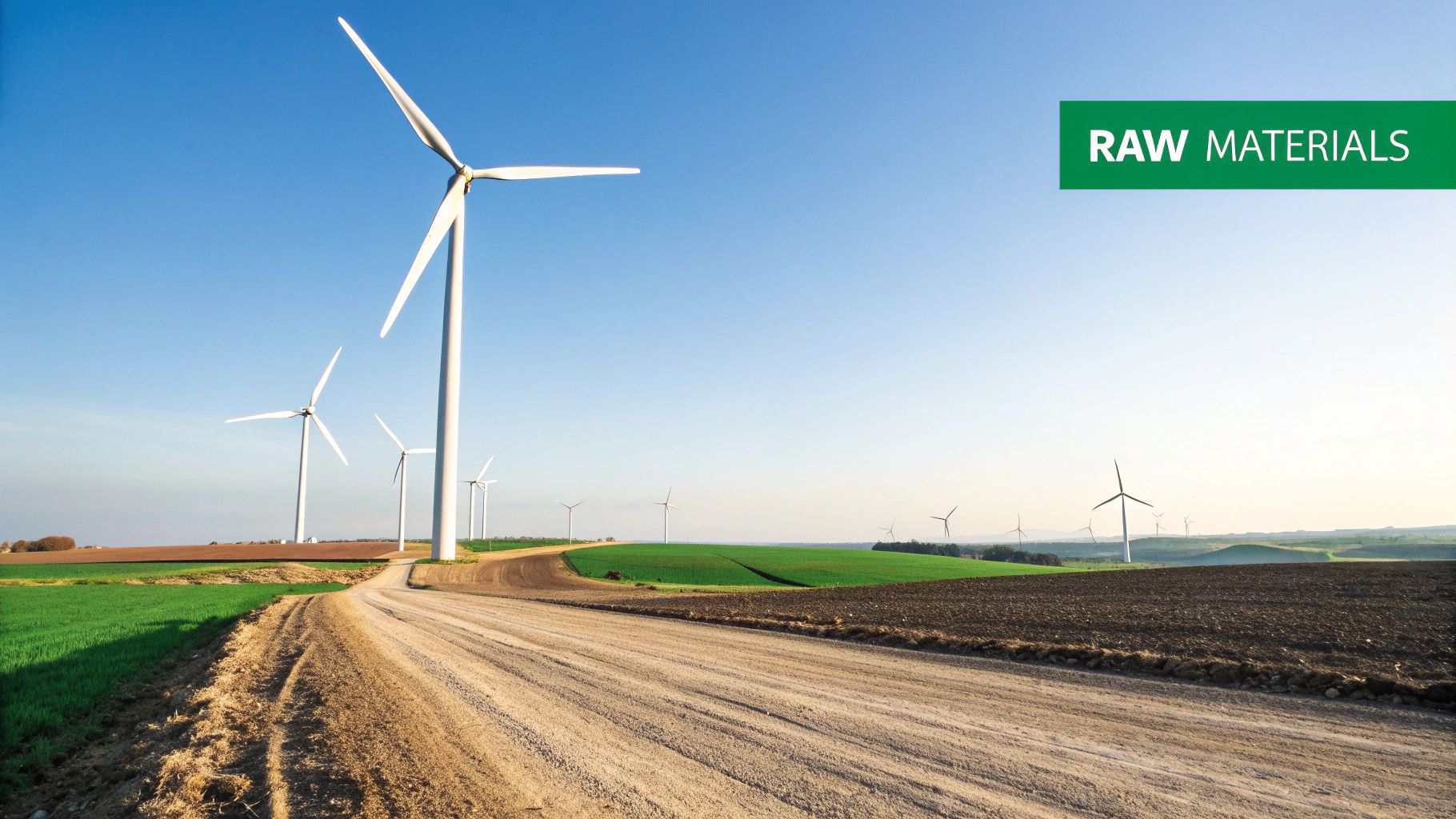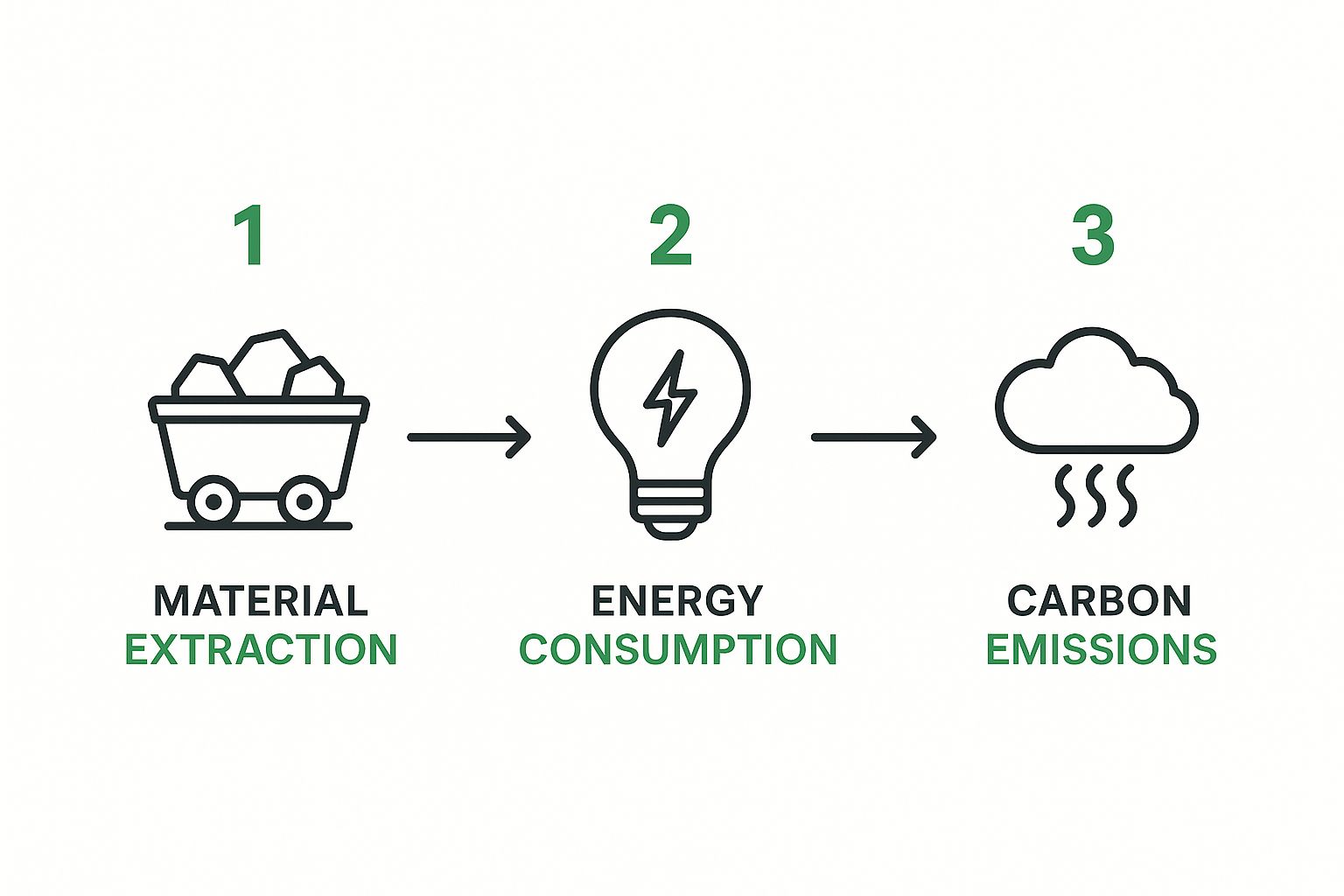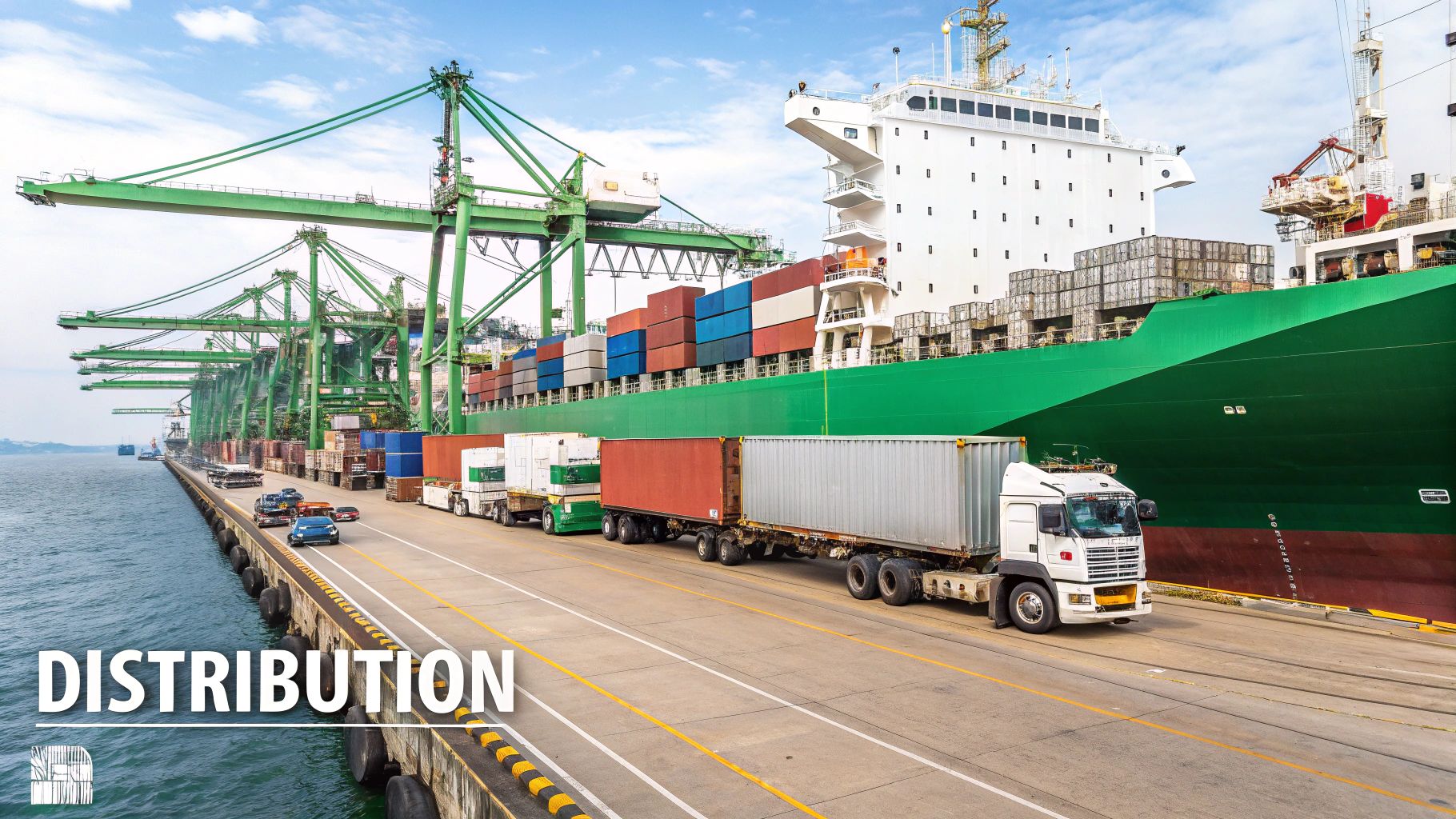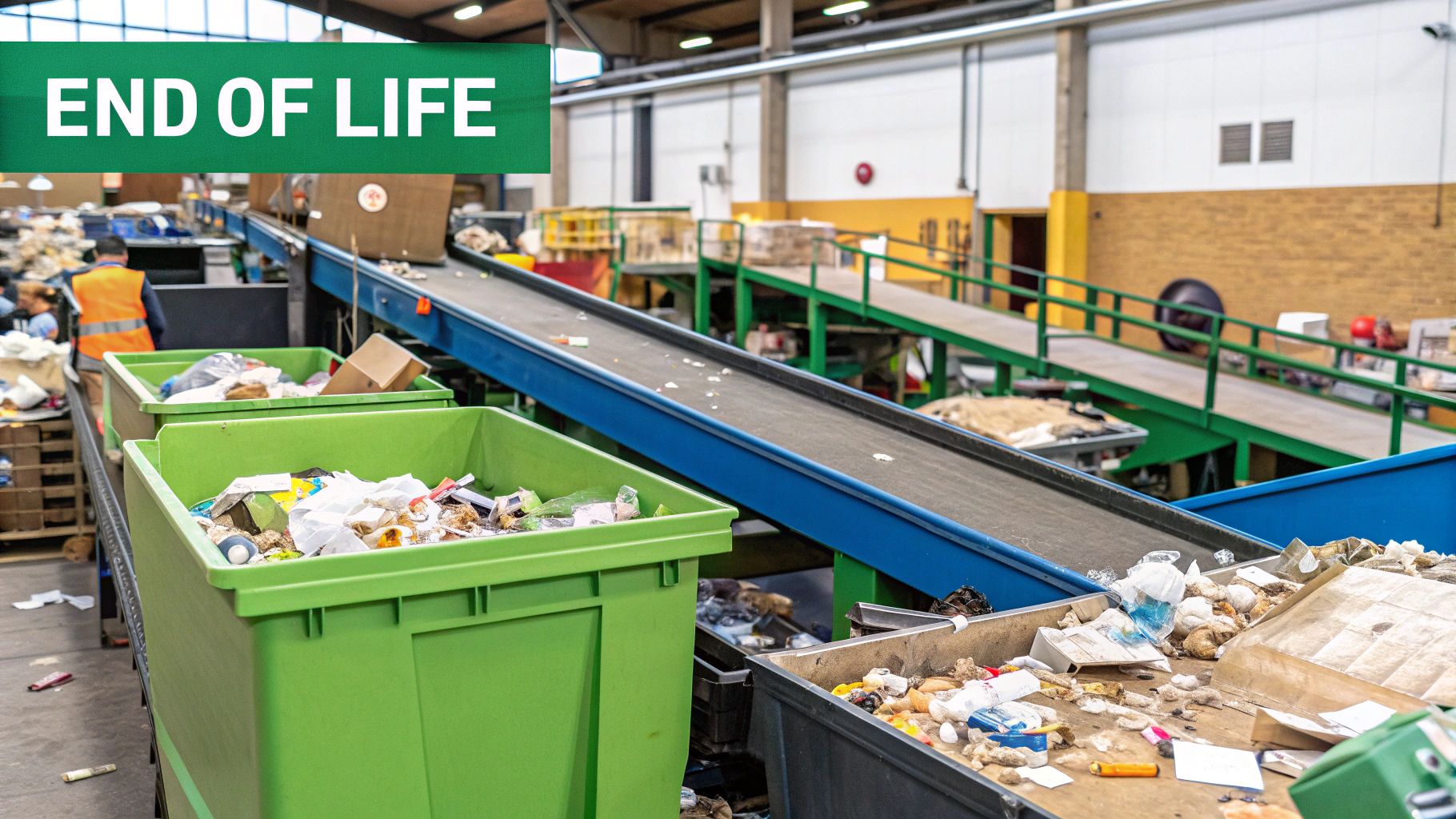A Guide to Carbon Footprint by Product Lifecycle
Karel Maly
July 19, 2025
When we talk about a product’s carbon footprint by product lifecycle, we're looking at the grand total of greenhouse gas emissions it’s responsible for, from the very beginning of its existence until the very end. This "cradle-to-grave" perspective adds up the environmental cost at every single stage. It’s the product's complete environmental story, written in carbon.
Tracing a Product's Hidden Environmental Story

Every single product you own has a secret history. It’s a story that starts long before it ever reaches your hands and carries on long after you’re done with it. This journey is its lifecycle, and it leaves an environmental trail at every step.
Think of it like an "environmental CV". Each stage of the product's life adds a new line item, contributing to its total impact. Typically, this journey includes several key phases:
- Raw Material Sourcing: The energy spent digging materials out of the ground or growing them in a field.
- Manufacturing: The factory processes that shape those raw materials into a finished product.
- Distribution and Transport: The trip from the factory to the warehouse and, finally, to your doorstep.
- Consumer Use: The power the product draws or the emissions it creates while you're using it.
- End-of-Life: The resources needed to dispose of, recycle, or break down the product once it's no longer needed.
Why a Complete View Is So Important
Just looking at one stage, like manufacturing, gives you a dangerously incomplete picture. A full lifecycle assessment is crucial because it uncovers the hidden carbon hotspots you might otherwise miss.
For instance, an electric car boasts zero tailpipe emissions while it’s on the road, which sounds great. But its manufacturing, particularly the creation of its battery, comes with a heavy upfront carbon price tag. To truly grasp a product’s impact, you have to look at the whole picture, similar to how one might evaluate a building's whole life carbon costs.
This complete perspective helps us avoid "carbon tunnel vision"—where fixing a problem in one area accidentally makes a bigger mess somewhere else. It ensures that our efforts to be sustainable are actually working.
This is especially critical for industrialised economies like the Czech Republic. According to the OECD, its economy is one of Europe's most carbon-intensive, mainly because of its deep reliance on fossil fuels. This means products made there often begin their life with a higher-than-average carbon footprint, making a full lifecycle approach essential for finding where to make real, meaningful reductions.
The Five Stages of a Product's Carbon Journey
To truly get a handle on a product's carbon footprint, you can't just look at the finished item. You have to think of it as a journey, a complete story with a beginning, a middle, and an end. Each step along the way, from the raw materials being pulled from the ground to the moment it's thrown away, contributes to its total emissions.
Let’s follow this journey using something we all know: a simple glass bottle. It’s a perfect, tangible example that helps bring the five critical phases of a product’s carbon story to life.
1. Raw Material Extraction
The story of our glass bottle starts long before it’s even a bottle. It begins deep in the earth. To make glass, we need to get our hands on silica sand, soda ash, and limestone. Pulling these materials out of quarries and mines involves heavy machinery that burns a lot of fuel and spits out emissions.
And that’s just the first part. Getting these bulky, heavy materials from the mine to the factory adds another layer to the carbon bill. The journey has barely begun, and already, a footprint is forming.

This image really drives home the point: a product’s environmental impact is set in motion well before it ever takes a recognisable shape.
2. Manufacturing and Processing
Once our raw materials finally reach the factory, the real work begins. This is often where the carbon footprint explodes. For our glass bottle, all that sand, ash, and limestone gets tossed into a massive furnace and melted down at scorching temperatures over 1,500°C.
Keeping a furnace that hot requires an incredible amount of energy. Depending on how the factory gets its power—whether from renewables or a coal-fired plant—this stage can be a colossal source of emissions.
It’s a crucial reminder: a product's carbon footprint isn't just about what it's made of, but also where it's made. The carbon intensity of the local electricity grid gets baked right into the product itself.
Of course, it doesn't stop there. The molten glass has to be formed into a bottle, cooled down, and then packed up for shipping, all of which uses even more energy.
3. Distribution and Transportation
Our bottle is now made and sitting in a box, but it’s no use to anyone at the factory. The next stage is all about getting it to the consumer. This covers every single kilometre it travels—from the manufacturing plant to a distribution hub, then on to a retail shop, and finally into a customer's shopping basket.
The emissions generated here can vary wildly based on a few key things:
- How it travels: Flying goods is a massive carbon-emitter compared to sending them by sea, rail, or truck.
- How far it goes: It's simple, really. Longer supply chains mean more fuel burned and more emissions.
- How efficiently it's packed: A completely full truck is far more efficient per bottle than one that's only half-empty.
4. Consumer Use
Now the bottle is in someone's home. For many products, like a television or a washing machine, this "use" phase is a huge part of its lifetime carbon footprint. Think of all the electricity it consumes over the years.
A glass bottle, on the other hand, is a pretty passive item. Using it directly doesn't really generate any emissions. But there's an indirect impact to consider. If that bottle of juice is kept in the fridge, it's adding to the refrigerator's energy consumption. If you give it a hot-water rinse before recycling, the energy used to heat that water adds a tiny—but still measurable—amount to its lifecycle impact.
5. End-of-Life
So, what happens when the bottle is empty? This is the final stage of its journey, and it’s a critical one. Does it get chucked in the bin and sent to a landfill, where it will sit inert for thousands of years? Or is it sent for recycling?
Recycling is, by far, the superior choice. In fact, making a new glass bottle from recycled glass uses significantly less energy—up to 30% less—than making one from scratch with virgin raw materials. This really shows how designing a product with its end-of-life in mind can dramatically influence its total carbon footprint.
To put it all together, this table breaks down the five core stages and highlights the main activities that generate emissions at each step.
Product Lifecycle Stages and Key Emission Sources
| Lifecycle Stage | Primary Emission Sources | Example Activity |
|---|---|---|
| Raw Material Extraction | Fuel for machinery, transport from source | Mining for silica sand, transporting it to a factory |
| Manufacturing & Processing | Energy for factory operations, process emissions | Melting sand in a furnace at 1,500°C to create glass |
| Distribution & Transportation | Fuel for trucks, ships, planes | Shipping finished bottles from a factory in Europe to a retailer in the UK |
| Consumer Use | Indirect energy consumption | Refrigerating a beverage inside the bottle |
| End-of-Life | Transport to disposal/recycling facilities, energy for recycling | Transporting used bottles to a recycling plant to be crushed and remelted |
Understanding these stages gives us a complete picture, showing that a product's carbon story is written long before and long after we actually use it.
How Raw Materials Define a Product's Carbon Cost

A product’s environmental story begins long before it ever hits a production line. The journey from raw material to the factory gate—what we often call the 'cradle-to-gate' phase—loads it with an initial carbon debt that it will carry for the rest of its life.
This first stage of the carbon footprint by product lifecycle is all about the materials chosen and where they come from. Think about it: digging up virgin resources like metals from a mine, drilling for oil to create plastics, or clearing ancient forests for timber are all incredibly energy-hungry activities. They rely on heavy machinery, complex transport networks, and massive land disruption, all of which pump out significant greenhouse gas emissions.
The Power of Recycled Content
So, what’s the single most effective way to shrink this initial carbon cost? It's simple: choose recycled content instead of virgin materials.
Using recycled aluminium, for instance, takes up to 95% less energy than smelting it from raw bauxite ore. That one decision can slash a product's starting emissions before it even gets close to a factory. This is the circular economy in action. By designing products that are easy to take apart and recycle, we can stop treating waste as a problem and start seeing it as a valuable resource for the next wave of products. This thinking turns the old linear path to the landfill into a continuous, low-carbon loop.
The materials you choose at the design stage are like a product’s DNA. They predetermine a huge portion of its lifetime environmental impact, setting a baseline that no amount of downstream efficiency can completely erase.
Of course, tracking these upstream impacts is a real challenge. The first step is getting a clear view of the emissions tied to your raw materials. To get a handle on the complexities, you can explore our detailed guide on carbon accounting for supply chains.
When Natural Systems Tip the Balance
The carbon cost of raw materials isn’t just about industrial processes; it’s also deeply tied to the health of our planet’s ecosystems. Deforestation for farming or timber, for example, doesn't just release the carbon stored in the trees. It also destroys the very forests that act as vital carbon sinks, helping to keep our climate stable.
A powerful, real-world example of this is unfolding right now in the Czech Republic. For a long time, its vast forests were a crucial carbon sink, pulling more CO₂ out of the atmosphere than they released. But a devastating bark beetle outbreak has ravaged these forests, temporarily flipping them into a massive source of emissions—to the tune of 10 million tonnes of CO₂ equivalent per year.
This ecological disaster has massively inflated the lifecycle footprint of local wood products. The very ecosystems that should have been offsetting their impact are now adding to it. As you can see in the full analysis of decarbonisation pathways in the Czech Republic, it’s a stark reminder that a product's carbon story is always intertwined with the health of the planet.
Why Manufacturing Is a Carbon Hotspot
If a product's carbon story has a villain, manufacturing is usually it. This is where a product’s lifecycle emissions often skyrocket. The factory floor is where raw materials become finished goods, a process that demands an immense amount of energy and makes this stage a real carbon hotspot.
Think of an old-world blacksmith hammering a sword into shape. The intense, constant heat needed to work the metal came from a roaring fire. Modern factories are no different; their furnaces, assembly lines, and machinery are today's fires, and they run on a colossal scale, consuming energy around the clock.
The Energy Source Makes All the Difference
The crucial part of the story isn't just how much energy is used, but where it comes from. A factory running on wind or solar power will have a dramatically smaller carbon impact than one plugged into an electricity grid that burns coal and natural gas.
This is a particularly big deal in a place like the Czech Republic, where the national energy mix is still quite carbon-intensive. The electricity supplied to a Czech factory comes with a hidden carbon cost, which gets baked into every single product that leaves the assembly line. It means two identical items can have vastly different carbon footprints simply because of the country they were made in.
A product's manufacturing emissions directly mirror the carbon intensity of the energy grid that powers its creation. A "dirty" grid passes that carbon legacy straight onto the product.
Let's make this real. A recent Product Carbon Footprint study looked at a thermal insulation coating produced here in the Czech Republic. The analysis showed that one standard unit of the coating carried a total global warming potential of 1.39 kg of CO₂ equivalent. The lion's share of those emissions stemmed from the manufacturing stage, a direct result of the factory's high energy needs and the carbon-heavy national grid. You can see this link clearly laid out in the full analysis of the product's emissions.
This really drives home the point that cutting a product’s footprint goes beyond just optimising factory processes. It’s fundamentally linked to the much bigger task of decarbonising a whole country's energy system. Of course, once the product is made, it still needs to get to the customer. For a closer look at that part of its journey, you can explore the carbon impact of shipping and logistics in our dedicated guide.
Actionable Strategies to Shrink Your Product's Footprint

Knowing your product's carbon footprint is the first step, but the real work begins when you start to shrink it. This is where we move from just looking at the numbers to making real, tangible changes at every stage of a product's journey.
It's all about making conscious choices that lower a product's environmental cost, from the moment it's conceived to the day it's thrown away. These aren't just abstract ideas; they are practical steps that lead to better, more responsible products.
Redesigning for a Lighter Impact
The best time to cut a product's carbon footprint is before it’s even made—right at the design stage. Smart thinking here can have a massive ripple effect, slashing emissions across the entire lifecycle.
Here are three key areas to zero in on:
- Design for Durability: Build things to last. A longer lifespan means people buy fewer replacements, which dramatically cuts down on the total emissions from materials and manufacturing over time. It's a direct challenge to our throwaway culture.
- Design for Disassembly: Make it easy to take your products apart. This sounds simple, but it’s crucial for effective repairs and recycling. It means valuable materials can be recovered and given a second life instead of ending up buried in a landfill.
- Material Selection: Be deliberate about choosing low-carbon and recycled materials. For instance, opting for recycled aluminium can reduce material-related emissions by up to 95% compared to using brand-new ore. That one decision can put a product on a far more sustainable path from day one.
Optimising Core Lifecycle Stages
Once you have a solid design, the focus turns to the production and delivery phases. Even in sectors that use a lot of energy, there's always room for improvement.
One of the biggest wins comes from improving energy efficiency in your manufacturing processes. Research from the Carbon Trust has shown that companies actively working on carbon reduction can see cost savings of up to 20% through better energy and waste management. This often involves upgrading to more efficient equipment or simply tweaking production schedules to be smarter.
A product's final carbon score is a direct reflection of the choices made at every single stage. From the mine to the factory, and from the delivery truck to the recycling bin, every decision matters.
For any business serious about making a deep cut in its environmental impact, learning about building a successful circular economy business model is a game-changer. It’s a completely different way of thinking that rejects the old "take-make-waste" model in favour of a closed-loop system where resources are used again and again.
Enabling a Circular End-of-Life
A product’s final chapter is just as important as its first. A smart end-of-life plan is essential for cutting down on waste and holding onto the value of the materials locked inside your product.
This means putting real effort into promoting recycling programmes that are simple for customers to use. It also involves setting up clear take-back schemes, where you, the manufacturer, take responsibility for your products after they've been used. This not only keeps items out of the landfill but also secures a steady stream of recycled materials for your next production run.
Taking these steps across the lifecycle is fundamental. For businesses ready to take their efforts to the next level, our guide on how to reduce your business carbon footprint offers more high-level strategies for company-wide change.
Frequently Asked Questions
Getting to grips with lifecycle analysis often brings up a few common questions. Here, we tackle some of the most frequent ones to help clarify the key ideas behind measuring and managing a product's carbon footprint.
What’s the Difference Between a Product and Company Carbon Footprint?
It helps to think of it as the difference between a detailed close-up and a wide-angle shot.
A company’s carbon footprint is the big picture. It adds up all the emissions an organisation is responsible for — from the fuel burned in its own vehicles (Scope 1) and the electricity it buys (Scope 2), right through to everything else in its value chain, like business travel or investments (Scope 3). It’s a holistic view of the company's total impact.
On the other hand, a product carbon footprint (PCF) zooms in on a single item. It meticulously tracks every gram of greenhouse gas tied to that one product’s journey, from sourcing its raw materials (the 'cradle') all the way to how it’s thrown away (the 'grave'). While a company’s footprint will include its products, the PCF gives you the specific, granular data needed to make meaningful changes to a product's design, materials, or manufacturing process.
Why Is the Use Phase So Important for Certain Products?
The significance of the 'use' phase really comes down to what the product does. For anything that needs energy to run—think cars, refrigerators, or laptops—this stage is often the single biggest source of emissions. In fact, for many electronics and vehicles, the emissions from a lifetime of use can completely overshadow the carbon cost of making them in the first place.
Contrast that with a passive product, like a wooden chair or a glass bottle. Its direct emissions during use are practically zero. However, that doesn't mean there's no impact. You still have to consider the energy needed to wash a shirt repeatedly or the electricity used to keep a bottled drink cold. This is exactly why looking at the full lifecycle is crucial; it helps you spot the real carbon hotspots, which aren't always where you'd expect.
Relying on offsets without making direct, internal changes to a product's lifecycle fails to address the root cause of the emissions problem. The first and most critical step is always to reduce.
How Can I Find a Product's Lifecycle Carbon Footprint?
Finding this data isn't always simple, but it's definitely getting easier as more companies get serious about transparency. Your best bet is to look for official reports and labels.
Here’s what to watch for:
- Environmental Product Declarations (EPDs): These are formal, independently verified documents that provide transparent data on a product's environmental impact across its entire lifecycle.
- Product Carbon Footprint (PCF) Labels: A growing number of brands are putting simplified carbon labels right on their packaging or product web pages to show an item's footprint at a glance.
You’re most likely to find these for things like construction materials, electronics, and some food items. If you can’t find a formal report, you can still make an educated guess by choosing products made with recycled materials, designed for a long life, and sold by companies that are open about their switch to renewable energy.
Are Carbon Offsets an Effective Reduction Strategy?
Carbon offsets can be part of the solution, but they should always be the last resort in a climate strategy, not the starting point. The idea behind offsets is to compensate for your emissions by funding projects somewhere else that reduce or capture greenhouse gases—things like planting forests or building wind farms.
However, the golden rule here is to reduce first. That means making direct cuts within your product's actual lifecycle wherever possible, whether it's by improving factory efficiency, sourcing low-carbon materials, or planning better transport routes. Offsetting should only come into play for those stubborn, unavoidable emissions that are left over after you've done everything else you can to bring them down.
Managing emissions across a complex product lifecycle demands precision and automation. Carbonpunk offers an AI-driven platform that gives you high-accuracy, real-time CO₂ monitoring for your entire supply chain. Stop guessing and start making data-driven decisions to shrink your carbon footprint. Learn how Carbonpunk can transform your carbon management strategy.